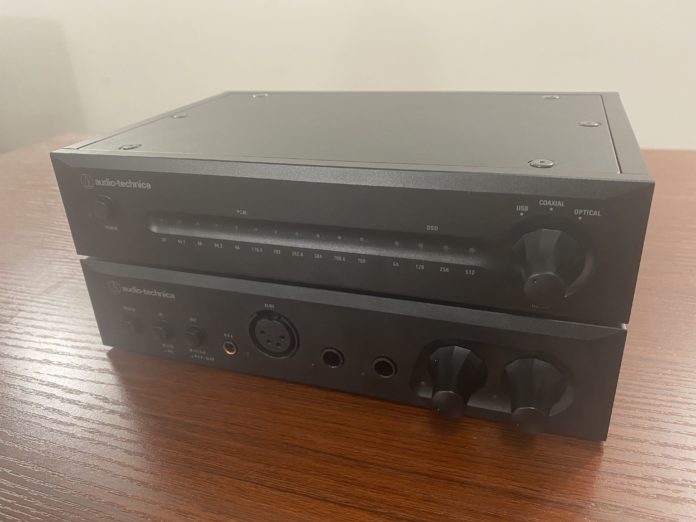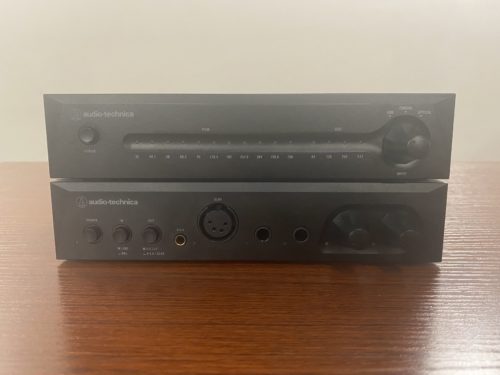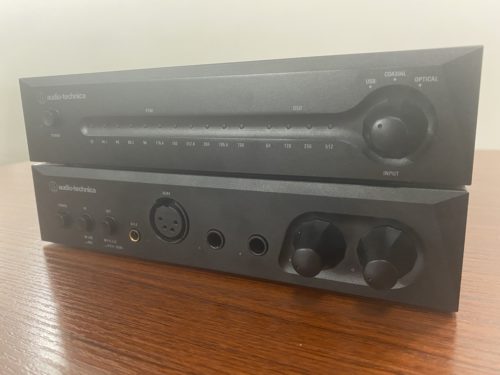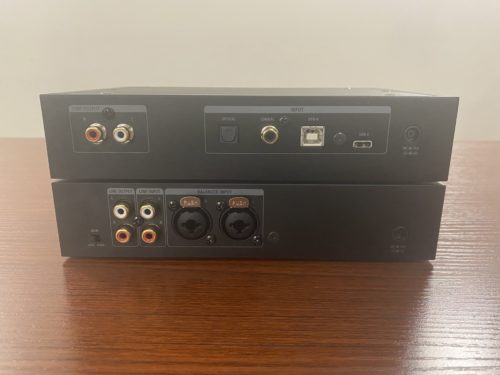Most of us in the audio world know Audio Technica for its wide selection of headphones, mics, and other pro gear. Part of the “other” section of their library is DACs and amps, of which they don’t have a huge selection. Thankfully, I’ve gotten to check out two of these models, the AT-DAC100, and the BHA100 headphone amplifier. I’ve been looking forward to checking these units out for myself to see what Audio-Technica can do in a field they’re not particularly known for.
What You Get
Both systems come packaged with the same contents.
- Audio-Technica DAC100
- AC adapter
- 6ft power cable
- 2 stands
Build
This is the standard black box chassis that you’re used to seeing in a lot of desktop units. The same goes for the BHA100 as well, but much larger in length. For the DAC100, the look is simple and classy, clearly showing you everything it can do right on the face of the unit. This is mainly a series of LEDs that display important information like sample rate and DSD operation, with a single knob used as a selector between USB, coaxial, and optical. The rear side of the DAC100 supplies RCA line out, optical, USB-C, and USB-B, with a port for DC power input. As for the BHA100, you get a similar clean row of information and inputs, but here there are a lot more features. One of the most unique aspects of the DAC/amp combo is the fact that you can listen to two headphones at once using dual quarter-inch headphone connectors. In addition to that, you have two balanced connections for both 4-pin XLR and 4.4mm connections.
Design
It’s been a while since we’ve seen the implementation of an AKM chipset, and I’m glad to see it back in use here inside the DAC100. An AKM AK4452VN is implemented with two channels for superior dynamic range and high signal-to-noise ratio. The DAC100 is in line with Audio-Technica’s standard for accuracy with its interior components such as its LME49860 designed by Texas Instruments. With this system, the DAC100 is able to supply low noise output and more persistent transient responses. This is a DAC specifically designed for its amplifier companion, the BHA100, to the point where its system is specifically tuned for its vacuum tube. The amplifier uses an additional four circuits to help focus the warm timbre that the tube brings and helps expand its level of depth.
Sound Quality
Knowing the Audio-Technica for years of my life, I’ve become familiar with the standard fidelity they’re able to put out. For me, their line of amps and DACs aren’t as familiar, so I was very interested to see how they were able to enhance my listening experience. The answer isn’t as easy to nail down in just one sentence. As a brand, Audio-Technica is mainly known for its output of pro-audio gear, and when listening to the DAC100 that is the feeling I get. Even when paired with its most likely companion, the BHA100, this system isn’t concerned with coloration or tone.
What it is concerned with is providing its listener with a clear representation of what their music and headphones truly sound like. There is some added warmth with the tube amp, but its effect can be inconsistent at times. However, I did not feel like this was a detriment to the intended sound signature the DAC100. It aims for accuracy and sticks with it, so much so that not even a tube pairing could compromise the sound as much. I would definitely recommend a reference style headphone when using the DAC100, like the Denon D7200 or Beyerdynamic DT1990. I also used spent some time with the Sennheiser HD800s and the detail was as crisp as ever. In fact, it was easier to notice the tube amp effect here, as felt the low-end featured the slightest bit of prominence with its fuller tonality.
The shape of the mid-bass definitely appeared considerably more rounded than usual, improving on some of the thinness that some listeners point out when using the 800s regularly. Midrange detail is still rich and resolving, albeit a bit underpowered with the BHA100. Some of the frequencies lack a bit of accentuation, but if you’re only looking for a wholly transparent experience, then I’d say the DAC100 does the job much more consistently than other characteristics. For instance, there was not much feeling of air in the high-end, even when keeping its blissful ring and added soundstage height. This doesn’t hurt the depth of the soundstage at all, but it does take away some spatial aspects of the imaging. What it creates though is a more realistic portrayal of that image, exaggerating nothing, and adhering to a space where the layers of sound can still operate articulately.
Switching over to the balanced headphone input on the BHA100, I was able to get a lot more of that texture the tube is supposed to bring. I used the MEZE Empyrean with the 4-pin XLR connector that’s provided on the amp, and I definitely received a much more sizable warmth. The DAC100 is able to provide a signal that puts more meat on the bone in this scenario, however, it never losses its precision. You’re able to perceive a more resonant bass timbre with a significant amount of body even going into the low-mids. With this added texture the DAC100 never loses focus on detail retrieval and clarity.
Summary
This DAC/amp combo does what it sets to do very well as a piece of pro-audio gear. Depending on the headphone you’re using, its vacuum tube could either make all the difference or none whatsoever as I tested with various headphones. Another one of its flaws is power when hooking up two different headphones to the amp and listening at the same time. The splitting of the gain really only works for low impedance headphones, as I had to park the volume knob pretty far in order to reach a suitable gain. However, just using one headphone definitely gave me enough drive to get all the goods that this combo can provide, and at the end of the day left me satisfied.
Both the Audio-Technica AT-DAC100 and BHA100 are available at Audio46.
Compare the ranking of various headphones, earbuds and in-ear monitors using our tools.
Discuss this, and much more, over on our forum.
---MAJORHIFI may receive commissions from retail offers.


















